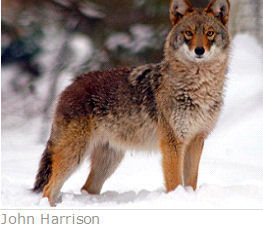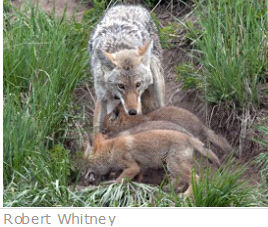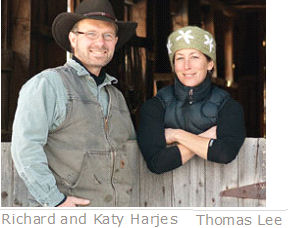
Unfairly accused of widespread sheep deaths, coyotes are among the most persecuted predators in North America, All Animals magazine
By Karen E. Lange
February 1, 2013 (San Diego)--The lucky ones hide when the helicopters and planes appear overhead. Most coyotes, though, take off running for their lives. And this is just what the men from Wildlife Services want. Armed with Benelli shotguns modified to fire six or seven times in quick succession, they shoot and shoot again at the animals flushed from cover. They’re flying so low—sometimes as little as 20 to 100 feet off the ground—it feels like they’re shooting sideways. It’s easy to hit the coyotes: Some take a shot to the chest and die instantly. Others are merely wounded and crawl off to lingering deaths. Any the gunners miss, they can get on the next pass. Or the next. They stop only when they’ve shot every single coyote—when they’ve knocked down all the predators on the ground.
“They kill them as fast as they can and in as big a volume as they can,” says Rex Shaddox, who was certified as an aerial gunner by Wildlife Services, the incongruously named animal killing program of the U.S. Department of Agriculture. Sickened by the indiscriminate slaughter, Shaddox later quit the agency and helped the U.S. Fish and Wildlife Service investigate his former employer. He’s watched many coyote culls. “[They kill] coyotes, mountain lions, anything they can see. … A lot of times they’ll shoot [a coyote] and roll it and shoot it through the hindquarters. [It’ll] be jumping around, screaming and hollering and barking … dragging its rear end on the ground.”
Each year, Wildlife Services kills around 32,000 coyotes like this, en masse, on public lands and private ranches, usually before the spring lambing season. On a “good” day, a gunner can shoot 50 to 100 coyotes. These aren’t problem animals preying on flocks. Many coyotes never eat a sheep; their natural diet consists of rabbits, rodents, fruit, and fawns. These are animals killed merely for being coyotes. Carter Niemeyer, a former Wildlife Services district supervisor, describes the reasoning: “They can’t kill sheep if they’re dead.”
Add to the aerial gunning victims the casualties of the agency’s other killing methods—the coyotes called from hiding and then shot by agents on the ground; the ones strangled in snares, caught in painful leghold traps, or poisoned; and the pups gassed or dug out of dens and bludgeoned to death—and the federal government takes the lives of more than 80,000 coyotes annually.
The more you kill, the more are born. It's a never-ending cycle of slaughter...that costs taxpayers millions of federal dollars annually.
For ranchers, the proposition can seem like a good deal: Pick up the phone if you’re worried about coyotes, and call Wildlife Services to come and kill the animals. It often costs ranchers nothing. For counties and states, too, it seems like a bargain. Under “cooperative agreements,” they pay only around half the cost, while the federal government picks up the rest of the tab.
But the thing about coyotes is, the more you kill, the more are born. So the drop in population never lasts long. The next year, Wildlife Services must return and kill all over again. It’s a never-ending cycle of slaughter that keeps the program in business and costs taxpayers millions of federal dollars annually (plus what Wildlife Services gets from local governments and other partners). The agency won’t release exact figures but has said it spends $13 million a year on livestock protection. A 1995 Government Accountability Office report found that most of Wildlife Services’ livestock protection spending went for lethal control. The agency’s own stats show that coyotes represent more than two-thirds of the mammalian predators it kills. You might call it a war on coyotes, except that it’s so ineffective and the hunters and trappers waging it know they can’t possibly win. They’re a little like the cartoon character Wile E. Coyote, endlessly stalking the Road Runner and ending up with a 250-pound anvil on his head.
The justification for all this violence is dubious; far more sheep die from disease and bad weather than are killed by coyotes. And there are proven, humane ways of keeping sheep safe, which some ranchers are already using. Wildlife Services says it invests $12–13.7 million, or 75 percent of its research budget, into developing nonlethal methods. But the good work the agency is doing in research and development isn’t being applied by its agents in the field. They kill the same number of coyotes year after year, says Stephanie Boyles, an HSUS scientist who works to reform the agency. “You’d think by now we’d get it. Instead of giving a rancher money to hire USDA to do aerial gunning, wouldn’t it be better to use that money to hire human shepherds?”
 Killing coyotes can lead to an increase in their numbers
Killing coyotes can lead to an increase in their numbers
Across much of the country, the coyote is a scapegoat—the only good coyote is a dead one. Camilla Fox, executive director of Project Coyote, calls the species “the most persecuted animal in North America” and estimates a half million are shot, snared, trapped, or poisoned each year in the U.S. by Wildlife Services agents, ranchers, and others.
The killing campaign started in the 1800s, when Western ranchers exterminated large native carnivores to create predator-free grazing land for cattle and sheep. They killed bears, mountain lions, wolves—and coyotes, North America’s wild dog, resilient and adaptable predators who leap into the air, legs pulled up and feet neatly curled into their bodies, and land unerringly on their prey.
Eighty-one years ago, Congress passed the Animal Damage Control Act, giving the government broad authority to kill wild animals deemed a threat to agriculture. One favored method: carcasses laced with strychnine. Bounties were offered for dead predators. It used to be that agents would string up dead coyotes on fence posts and hang the ears from rings on their pickups’ gun racks. The ears helped prove their kills so they could collect their money. Around 1980, Shaddox remembers, an order came for Wildlife Services agents to stop doing this—it was bad for the agency’s image. So, nowadays the corpses are generally piled in a heap on ranchers’ land.
Since the 1930s, the gray wolf has been nearly wiped out. The coyote, paradoxically, has thrived. One reason, scientists now realize, is coyote social organization. Coyotes live in groups where only the alpha male and female reproduce. However, if one member of that pair is killed, the group’s social structure is disrupted, and the surviving females start to have pups. With fewer coyotes competing for food, more pups are born in each litter, and more of those pups survive. Coyotes from outside the area also move in. The result: Within a year or two, there are as many or more coyotes in an area where the animals have been killed than before. Eric Gese, a Wildlife Services researcher, found that after 60 to 70 percent of the coyotes in an area of southeastern Colorado were killed, pack size and density rebounded within just eight months.
Infographic: Why killing coyotes doesn't work »
Ironically, coyote killing actually encourages survivors to eat sheep: Targeted populations have fewer adults to go out hunting and more young to feed, and sheep serve as a big and easy meal, writes Robert Crabtree of Yellowstone Ecosystem Studies, who’s researched the animals in California, Washington state, and Wyoming.
Coyotes are resilient because they had to be, explains Crabtree; they evolved in the shadow of the gray wolf, a bigger and more aggressive canid. Wolves kept coyotes in check, sometimes by killing them, more often by driving them out of their territories. Professor William Ripple of Oregon State University calls this “the ecology of fear.”
As humans altered this ecological balance by killing off the gray wolf, the coyote took over, expanding its range from Mexico, the Southwest, and the Midwest to nearly all North America, from Northern California to Alaska and the East Coast. Yellowstone coyote populations have dropped by half since wolves were reintroduced in 1995; elsewhere, they are limited only by the food supply, says Ripple.
“Having these huge numbers of coyotes is definitely an issue,” he says. “But we should question whether killing coyotes is really effective. We should start looking at the ecology and the cause of the problems, rather than work on the symptoms.”
In many places, coyotes have replaced wolves at the top of the food chain. They control populations of jackrabbits, rodents, opossums, and foxes. This in turn protects grass that cattle eat and birds who nest or feed on or near the ground.
Yet despite their role in the ecosystem, in much of the country coyotes are treated like “varmints.” In most states, they can be legally killed in any manner at any time. In Minnesota, a bill to allow bounties was approved last year; The HSUS helped defeat similar bills in Maine and North Dakota. Contests in at least 200 communities offer prizes for the biggest coyote or the most coyotes killed. Competitors summon the animals using imitations of coyotes in distress, then shoot them using high-powered rifles equipped with telescopic sights.
Elsewhere, in a practice known as penning, hunters release dog packs on coyotes in fenced-in enclosures. “They use them because they last a little bit longer than foxes,” says Casey Pheiffer, director of The HSUS’s Wildlife Abuse Campaign, which is working to end penning in Virginia, Indiana, and other states. “And nobody cares what happens to coyotes.”
 Campaigns to poison predators have tragic consequences
Campaigns to poison predators have tragic consequences
Angel Walker wishes she had at least gotten a call early last year when the killing campaign showed up on her doorstep. A county commissioner who leases land surrounding her yard for cattle pasture had decided to have his son, a Wildlife Services agent, place devices known as M-44s near her house. When animals sniff the bait, the spring-loaded devices fire sodium cyanide pellets into their mouths, where moisture turns the pellets into a lethal gas. The first that Walker knew about the M-44s was a 6-inch by 8-inch sign she saw posted on a cattle guard at the foot of her driveway one afternoon as she returned home. When she reached her front door, she found a note instructing her not to touch the M-44s. She thought immediately of her dog, Bella, a 1-year-old pit bull terrier with a sweet disposition whom she had picked out as a puppy: “She was my very first from-scratch dog.”
Walker didn’t know what an M-44 looked like but had reason to worry. At least a half dozen people—pet owners, people walking on public lands, even a U.S. Fish and Wildlife Service agent—have been sickened in recent years by sodium cyanide from M-44s. An unknown number of pet dogs and nontargeted wild creatures have been killed by sodium cyanide and a second highly restricted pesticide Wildlife Services routinely uses—Compound 1080, a chemical so toxic that experts worry bioterrorists could use it to poison the water supply. (The agency’s other coyote control methods result in lethal mistakes too; pets and nontargeted wild animals have been caught in leghold traps or asphyxiated in snares.)
Anxious about Bella, Walker went out with her son to search for the dog. They came upon an M-44 less than 1,000 feet from her house, on a walking trail used by her and her children, near a creek that flows into a lake from which the family got their water. The device, which resembled a shotgun barrel, was sticking up from the ground 3 inches. Scattered all around was orange yellow dust. In a nearby mesquite tree a tiny sign—3 inches by 3 inches—warned passersby. For two days Walker and her family and friends searched for Bella. They found plenty of M-44s, even though cattle don’t usually graze on the land around her house and they certainly don’t give birth to calves there—which is when they would be vulnerable to coyotes. Then, finally, Walker found her dog’s body, near the first M-44 she had spotted. Bella had started bleeding from her nose and mouth, fallen to the ground, gone into convulsions, and died.
“When we found her, you could see [on] her poor little mouth … the powdery yellow substance,” says Walker. “That’s all I remembered for a long time, imagining what she thought—‘Oh my gosh, I’ve done something wrong’—and [how] she started towards home.”
An unknown number of pet dogs and nontargeted wild creatures have been killed by sodium cyanide and...Compound 1080, a chemical so toxic that experts worry bioterrorists could use it to poison the water supply.
When Walker complained in town, she discovered the required paperwork for the M-44 had not been filed. Officials seemed unconcerned. The cattle rancher’s hired hand reset the M-44, which killed a fox. So she and her husband called the Texas Department of Agriculture about the sodium cyanide. But after an inspector visited the property, Walker discovered four dead coyotes strung up along the fence on the road leading to her house. Only following a call to Brooks Fahy of Predator Defense (who says he repeatedly complained to Wildlife Services) were the coyotes taken down. No one from Wildlife Services apologized to the Walkers and no one has been cited for negligence.
Unfortunately, the attitude the Walkers encountered is common among local Wildlife Services agents. That’s because they’re beholden to their “customers”—ranchers who in some states own most of the land where coyotes live, and who sometimes even provide housing for agents, says Shaddox. State Wildlife Services directors in turn promote lethal control because the cost-sharing agreements with local governments and others provide a lot of the funding for their offices, say agency critics. “The trappers on the payroll, most state directors are going to encourage them to get the job done—and getting the job done means killing coyotes,” says Niemeyer, whose persistent questioning of lethal control for wolves left him marginalized at Wildlife Services. “It’s real easy spending federal money. When private people have to pay for their own predator control, they’re going to find out how fruitless it is.”
At the national level, Wildlife Services is famously resistant to scrutiny. When The HSUS submitted a Freedom of Information Act request for records on 5,271 incidents between 2000 and 2010 in which M-44s killed nontargeted animals, it received information on just 58 of those cases. When WildEarth Guardians submitted FOIAs for details of the Wildlife Services budget, it was told these could not be provided because of the way the agency does its accounting. Even when members of Congress asked for specific budget amounts, they got nothing.
Despite the pressure to reduce the budget deficit, the Obama administration and Congress have refused to cut federal funding for the lethal arm of Wildlife Services. Last June, when Reps. John Campbell, R-Calif.; Peter DeFazio, D-Ore.; and Gary Peters, D-Mich., introduced an amendment to slice $11 million from Wildlife Services’ budget and halt the agency’s spending on lethal predator control, the measure was defeated after opposition from the NRA and the agribusiness lobby. This year, The HSUS and other groups are urging Congress and the Obama administration to at least end the agency’s use of Compound 1080 and sodium cyanide.
 New breed of ranchers prefers nonlethal control to protect sheep
New breed of ranchers prefers nonlethal control to protect sheep
Far from the Beltway, a quiet movement toward nonlethal control has been taking place. In the 1970s, ranchers started using guard animals: llamas and donkeys, who have an instinctual dislike of canids, and specially bred and trained dogs like the Great Pyrenees. Then, in the 1990s, some ranchers began to be certified as “predator friendly” to help market their products. At the time those two words made a lot of ranchers angry, says Becky Weed, who produces predator-friendly wool in Montana. Now just about everybody has a livestock protection animal. “The most important thing is that the guard dogs are with the sheep 24/7,” says Weed. “A government trapper can’t be.”
Ranchers like Weed also quickly remove carcasses of stillborn calves and other animals to avoid attracting scavengers. And they invest in electrified fences and closer supervision—moving animals into pastures away from predator sightings, bringing them into corrals at night, and keeping them in or near sheds during lambing. Fladry, or the practice of tying strips of cloth or plastic to fences, and noise and light devices can also scare coyotes away.
In 2000, Marin County, Calif., dropped its cooperative agreement with Wildlife Services and started giving money directly to 18 ranchers for nonlethal control. Elsewhere, in addition to Weed, a couple dozen other ranchers have officially gone predator-friendly, says Abigail Breuer, who’s in charge of the certification for the Wildlife Friendly Enterprise Network. At least 300 more—maybe 10 times that—qualify, she says.
This approach makes sense given the economic factors affecting the sheep industry. When wildlife biologist Kim Berger set out to quantify how much predation had hurt sheep ranchers from 1939 to 1998, she found that low lamb prices and high production costs had played a much greater role in the industry’s decline than coyotes. Predator control programs that cost an estimated $1.6 billion did not seem to have made a difference. (Now, with droughts in Australia cutting the supply of lamb, and demand up, the U.S. sheep industry is once more profitable.)
“Taxpayer dollars might be better spent to support sheep producers through direct cash payments or some other form of subsidy if the goal is to increase sheep and wool production and not merely to kill carnivores,” writes Berger in her 2006 report.
Researchers are working on additional nonlethal options. They’ve found that sterilizing coyotes reduces the likelihood they’ll prey on sheep by two thirds or more—enough to cover the cost of the surgeries, says Gese, at the National Wildlife Research Center field station in Logan, Utah. “It’s economical because [the coyotes] do maintain their territories,” says Gese. “A lot of ranchers remind me that bullets are cheaper, but with lethal control you have to do it every year.” If they can get funding, researchers would like to develop a nonsurgical contraceptive that also won’t alter coyote behavior and is cheaper and easier to administer. In addition, they hope to test breeds of guard dogs for their effectiveness against wolves, since some ranchers face both predators and may stop using guard animals if wolves kill their dogs, says Logan biologist Julie Young.
Boyles praises the research but says it seems to have no effect on the way agents operate. “There appears to be a huge chasm in the agency between the people that are developing nonlethal methods and the people that should be using them in the field.”
"If we lose 1 or 2 percent, that's the cost of doing business."
Ranchers like Richard Harjes, though, have embraced nonlethal tactics. When he and his wife, Katy, started raising sheep in 2008, their Montana ranch lay in a boxed canyon dense with coyotes. There was a pack to the north, a pack to the east, and a pack to the south. Looking for a way to avoid killing coyotes or the mountain lions or black bears living around their property, the Harjes discovered the type of livestock guardian dogs long used in Europe. The first year, when they had only one dog borrowed from a neighboring rancher, losses were steep—around 8 percent of their 500-animal herd, half from mountain lions and half from coyotes. Harjes would see the carrion birds in the pasture and know, instantly, he’d lost a sheep to a coyote (the mountain lions typically carried the bodies off).
The Harjes might have gotten discouraged and quit. Instead, they bought five dogs weighing 120 to 150 pounds apiece (to the coyotes’ average 25 to 30), who were bred and trained to bond with sheep and fiercely defend them. The second year losses fell to 4 percent, the third year to just 1.
“You create this standoff with dogs—the dogs are constantly peeing on things ... and walking along the fences,” says Harjes, who figures he’s training his local coyote packs as well as the dogs. One day he stepped out of his house to see a coyote in the pasture. In the same moment, “the [dog] did a quarter-mile sprint and the coyote took off like a shot and just made the fence.”
Maybe, Harjes says, someday he will have to kill a coyote to protect his sheep. But it will be as a last resort. And so at night he listens, happily, to the coyotes’ distinctive yipping and howling. Sometimes, if they’re real close, he gets nervous and goes to check his sheep. Mostly, though, he trusts his dogs and enjoys the coyotes’ wild songs. “If we lose 1 or 2 percent,” he says, “that’s the cost of doing business.”
About This Series: This is the first story in a two-part series about the targeting of coyotes in rural and urban environments. Writer Karen E. Lange interviewed dozens of sources, including HSUS experts and other coyote advocates, ranchers, scientists, and former and current government officials.
Reprinted with permission from All Animals magazine, The Humane Society of the United States, humanesociety.org/allanimals.









Comments
Despicable
This is absolutely despicable. Humans do not have the right to kill animals en masse. Ever! You want to protect sheep, great, but don't do it by murdering hundreds of other animals every year. There are always nonlethal solutions to these types of problems. Killing should never be a consideration. Necessity is the mother of invention. If killing were taken off the table, they would find a better way in no time.